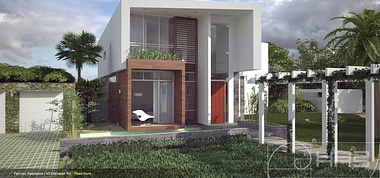http://ha3.co/project/barloa-sushi-grill-gh-hoteles
The Concept - The avant-garde trend applies to the whole restaurant, with reference styles used such as the Modernist and Deconstructivism architecture. From deconstruction of Japanese architecture, where the elements of nature meet justified on each element of space, elements are transferred to each component of the formula, hence the alchemy what gives long life to BARLOA sake & grill. The dining space exposes the implicit geometry of a Japanese cabana from Tokunoshima south coast region, surrounded by endless dark green forest, and the presence of seafood served as starring, juxtaposed to the composition of the whole.
Manila Ropes - The interest in using ropes as the scenic material will strengthen an identity. First the origin given by its owners, who began their experience with its first restaurant next to one beautiful yacht club in the Caribbean region. This valuable small restaurant on 2007 was baptized under name "Barloa sushi bar". Traditionally barloa or barloar, in maritime Spanish tongue is a word which determines the action to come alongside boats on the high seas, therefore offshore boats are insured, tied together... Thereafter we chose to investigate and translate our interpretation of ‘bounding’ with the use of Manila ropes. The ropes held in tension at specific points form a shape of Japanese cabana or a hut. A cabana, whether it be a tea house or sake house is a sacred place in traditional Japanese times. It is a place where people drank in harmony.
The Sushi and Robata counter function at the same space for self-service. The essence of the space is in stark contrast with the dining area, even sharing the same unit; we wanted to achieve a sense of humbleness but at the same time minimalist and elegant. The dining area is distributed from the center to the perimeter, In its perimeter and following the direction of clock’s needle begins the food counters, then continued over the lounge bar and finally down to the chill out area.
Material and detailing strategies - The principle material for this project consists of Manila ropes, steel, timber and concrete. Materials had to reflect on natural elements such as vegetation and earth. This is an intrinsic ideology of traditional Japanese Culture where people seek a connection with nature. The Manila ropes were secured (by screws and hooks) onto the metallic post/logs one end, slung over a steel rod and held in tension at the other end through the similar method of screw/hooks fixing.
The Finishes - The subtle contrast of warm gray materials was carefully managed through comparative samples of each material exposed to the combination, including the biggest break as is the light pine wood. The warm grays are represented at the foreground by concrete walls and natural finish left by the timber above formworks, then as the background there is a strong presence represented by the main wall clad in Spacatto fuming or charcoal stone pieces in warm grays to black Guiana tones. The ceiling and walls are finished in black paint to throw the services elements into obscurity. Fitting out of the embellishment and the services into a heavy concrete waffle slab was a challenge.
Edges, Risers, Countertops - All the items will be arranged horizontally coated with Pine wood. And LED lighting is the one corresponding to these elements will be arranged under each. Terrazzo floor inking gives drama to the composition and looks resemble the black galaxy granite finish, in this way we obtain reuse existing white terrazzo floor.
Bathroom finishes - Ceramic flooring tiles with 70 x 70 cm, white ivory, sand, and intermediate polished, the walls will be coated with 70x70 cm ceramic tiles, warm gray color, a little bit light magenta, and low gloss polish. A secret within the bathrooms… Art printed in large format - Analyzing Asian artists, has been selected as appropriate to the design two well-known works from the contemporary painter and graphic artist "Takashi Murakami" from Japan. His art expresses humor and sarcasm, while it is universal and versatile. The art chosen for the men's bathroom is the texture "Jellyfish Eyes" and the women's bathroom black and white version of high resolution texture "Flowers".
The selection of furniture - It was done by the customer through our monitoring, where the effectiveness of each piece was tested to compose the concept exposed. Taking into account various collections of famous furniture/fixture designers, it was assumed as a criterion for selection, storing affinity with materials and finishing details of the enclosure.
Application of sustainable resources and principles - From the beginning this wonderful project was assumed as a case of study where the priority was to provide the customer with the desired response, taking in account unusual materials with the capacity to surprise and bring new choices in architectural finishes to hospitality spaces. Manila ropes are usually used for bounding cargo goods; once worn and rotten, they are disposed. Therefore we wanted to demonstrate an alternative uses for manila ropes. It is not just purely a material for securing goods; their properties can go further to meet the standards by which were produced industrially.
